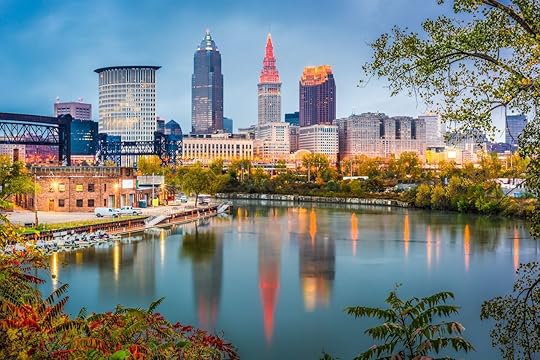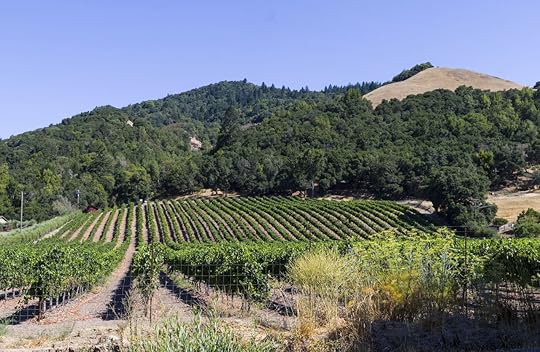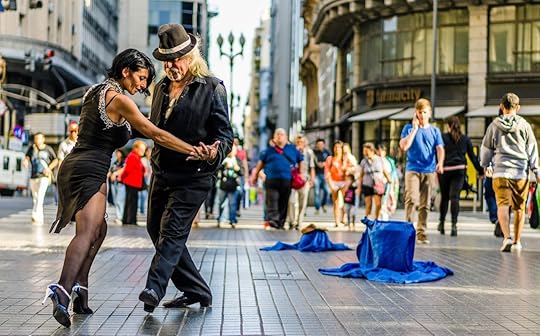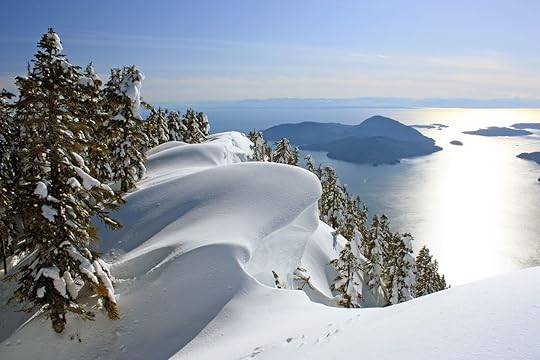Matador Network's Blog, page 1096
May 15, 2019
Spice Bus from ‘Spice World’ Airbnb

Spice Girls fans can finally relive the ‘90s the way they’ve always wanted — by staying in the actual Spice Bus from the 1997 “Spice World” movie. Suzanne Goley, a Spice Girls superfan, has converted the bus into a liveable, sleek apartment, and it’s now available for booking on Airbnb. The British-flag-painted bus sleeps three people and features a “Girl Power” neon light installation, potted plants, a widescreen TV, animal print carpet, a basket of scrunchies, disco balls, ‘90s magazines, and CDs for the ultimate throwback feel.

Photo: Airbnb
According to the listing, some notable bus rules include: ‘90s dress code, Girl Power essential, double denim permitted, selfies in the driver’s seat encouraged, and a compulsory rendition of “Goodbye” on check out.

Photo: Airbnb
“The Spice Girls were my childhood obsession,” said Godley. “And while I have grown up over the years, I don’t think I’ve ever grown out of my love for them. When my boss mentioned that he was considering buying the Spice Bus, I was desperate to be a part of its renovation. We’ve worked hard over the past few months to turn the bus into a home, in keeping with its legacy, and I’m so excited to open it up to the public with the support of Airbnb.”

Photo: Airbnb
The bus will be located in London’s Wembley Park and available for booking on June 14 and 15, though more dates may be added soon. One night will cost $128, and bookings open at 8:00 AM on May 22. 
H/T: Insider

More like this: The most epic place to rent in Airbnb’s most trending destinations
The post The Spice Bus from ‘Spice World’ is now on Airbnb appeared first on Matador Network.

Where to travel in July

July is like the Cheesecake Factory menu of travel months. Everything just looks big and bright and delicious, and you’ll make the poor waiter come back four times because the options are just so overwhelming. While we can’t help you decide between the Factory Burrito and Evelyn’s Favorite Pasta, we can offer you up our picks for the best places to travel in July.
Whether you’re looking enjoy July 4th fireworks somewhere beautiful, catch a baseball game, or finally spot that solar eclipse, we’ve got your July travel plans covered. So sit back, get a refill on your Diet Coke, and check out the best places to travel this July.
Houston, Texas

Photo: Sean Pavone/Shutterstock
If you believe in huge government hoaxes, Houston is THE place to be in July as the city celebrates the 50th anniversary of the quote-unquote “moon landing.” The entire month will be one big celebration of Neil Armstrong’s famous walk, kicking off with the July 4th Freedom Over Texas festival, featuring Jake Owen and Kellie Pickler.
July 16-24, Space Center Houston will have special pop-up Apollo science labs, mission briefings, and NASA tram tours of Mission Control. You’ll also have opportunities to lunch with mission controllers and flight directory from the Apollo era, plus an all-day festival on July 20 to commemorate the anniversary with real Apollo astronauts.
Cleveland, Ohio

Photo: Sean Pavone/Shutterstock
July weather in Cleveland is as good as it gets, when you can take a boat out on Lake Erie, shoot off on a day trip to Cedar Point, or lazily enjoy dinner in one of America’s best food streets on E 4th Street. This year, The Land will be especially exciting as its hosts the Major League Baseball All-Star game on July 9.
In addition to the usual festivities, like the Home Run Derby and Legends and Celebrity Softball Game, Cleveland will host the first-ever Play Ball Park. MLB is calling it the world’s largest baseball festival, where fans can peruse artifacts from the Hall of Fame in Cooperstown, meet former players, try their hand at VR Home Run Derby and preview the new Jackie Robinson Museum. It’ll also have live music and dozens of local food trucks, so you can taste the city without leaving downtown.
The Galapagos Islands

Photo: Jess Kraft/Shutterstock
Not huge into tortoises? We get it. But the Galapagos has a lot more than just looking at turtles. Diving is a huge attraction here, and July brings some of the best dives of the year with the arrival of the Humboldt Current. No, this is not a magic water flow that brings the “good stuff” from NorCal. It’s a current that runs from the Antarctic along the west coast of South America, with all kinds of cold-water marine life the islands don’t see the rest of the year.
Original Diving offers custom-built dive itineraries that’ll have you swimming with everything from whale sharks to hammerheads at the islands’ most famous sites like Gordon Rocks and Darwin’s Arch.
Mt. Fuji, Japan

Photo: Sakarin Sawasdinaka/Shutterstock
Haven’t jumped on the Japan bandwagon yet? Maybe you’re just saving the best for last, since when you climb Mt. Fuji in July you’ll have waaaay better pictures than your friend who spend six hours in the Cat Café. The peak climbing season for Japan’s tallest mountain falls this month, offering the friendliest weather and the best sunrises if you’re bold enough to trek overnight.
Since you’re already crossing the Pacific, you may as well spend some time seeing the rest of the country. And Inside Japan Tours runs a Tokaido Trail trip that’ll have you summiting Mt. Fuji, as well as exploring Tokyo, Kyoto, and Kamakura’s serene temple complexes.
Baltimore, Maryland

Photo: ESB Professional/Shutterstock
If you’re looking to spend July in the fabulous Mid-Atlantic outdoors, look no further than Baltimore for your mid-summer getaway. Not only will you have a chance to stroll the Inner Harbor and catch an Orioles game at Camden Yards, but you’ll also be able to attend the largest free outdoor festival in America. Artscape runs from July 19 to 21, where tents, exhibition spaces, and performing arts venues all over the city host events from dance to opera.
On Thursday nights, you can also catch outdoor movies at the American Visionary Art Museum during its summer Flicks from the Hill series. Or take in the smells and flavors from one of America’s best Little Italys near Fells Point. If you’re hellbent on seeing fireworks over the Potomac on July 4, Washington, DC, is only a short drive away.
Upstate New York

Photo: mervas/Shutterstock
Just because the triple crown is over, that’s no reason to ignore horse racing until next year’s Kentucky Derby. Brush up on your betting and head to Saratoga Race Course, one of the most beautiful tracks in the country, where the summer meet draws huge parties every weekend. For a more-upscale equine adventure, head to Saratoga Polo. Or go more downscale and watch live harness racing at the Saratoga Casino Hotel.
Over in Lake Placid, July 4 brings the annual Lake Placid Regatta, complete with fireworks over Mirror Lake. In Niagara Falls, they’ll be honoring the 50th anniversary of Stonewall at Pride at the Falls on July 5, including a free concert Buffalo Philharmonic, fireworks, and the falls lit up like rainbows.
Trencin, Slovakia

Photo: Leonid Andronov/Shutterstock
Summer Euro trips are nothing new, but how many people you know have been to Slovakia? Be a trailblazer and hit the little-known Pohoda Festival, about two hours from Bratislava. The festival runs from July 11 to 13, held in the shadow of Trencin Castle, an 11th-century landmark that’s one of the nation’s most enduring images.
And don’t worry, you won’t be listening to obscure Slovak bands you’ll have to pretend to like either. Headliners include Liam Gallagher, The Roots, The 1975, and Lykke Li. Once the festival is over, take some time to explore the small villages and High Tatra Mountains nearby. Or take a side trip into Vienna, which is only a couple of hours’ drive away.
Cheyenne, Wyoming

Photo: littlenySTOCK/Shutterstock
Most of the year, Cheyenne isn’t exactly what you’d call a sexy destination. But for a couple of weeks in July, it’s the capital of the Western world. Frontier Days take over Cheyenne July 18-28, bringing the world’s largest rodeo and western celebration to Wyoming.
In addition to the daily entertainment of bull riding, steer wrestling, and calf roping, Frontier Days boasts art shows, carnivals, and nightly concerts by acts like Keith Urban and Rascal Flatts. Afterwards, the parties spill into the bars and saloons of the city, where cowboys and the women who love them make every night feel like the Wild West.
Tanzania

Photo: Radek Borovka/Shutterstock
You know what’s cooler than being the first one of your friends to see the new, computer-animated Lion King movie? Going to actual Tanzania and seeing all the spectacular scenery and wild animals without the aid of CGI. The dry season in Tanzania makes July the ideal time to take a safari vacation through Serengeti National Park and the Ngorongoro Center.
Then take a little snorkeling excursion in the warm waters off Zanzibar, where the colorful fish add a little Finding Nemo to your real-life Disney trip. If you’d rather spend your whole time in the bush, Intrepid Travel offers an eight-day trip through the Serengeti Trial, where you’ll visit Tanzania and Kenya, game spotting and making stops at Lake Victoria along the way.
Santa Rosa, California

Photo: Bob C/Shutterstock
Perhaps the second most anticipated movie coming this summer is Wine Country, the new Amy Poehler vehicle about a girls’ weekend in California. No? Well even if female ensemble straight-to-Netflix movies aren’t your thing, you should be inspired to head to wine country this summer. Santa Rosa is the largest city in Sonoma County, the perfect place to base yourself on a tour through Northern California’s affordable alternative to Napa.
After last year’s devastating wildfires, the region is getting back on its feet opening its first new hotel since the fire at the Hotel E on July 1. From there you can spend your days imbibing in the sunshine, hitting noted wineries like Harvest Moon and Paradise Ridge. Or going straight to the source of Pliny the Elder at Russian River Brewing.
Buenos Aires, Argentina

Photo: Alexandr Vorobev/Shutterstock
Still got FOMO from the big solar eclipse that ran through America a couple years ago? Well one-up all your friends who flocked to the middle of Nebraska to see full totality and get yourself down to South America for this year’s eclipse on July 2. Though most of the path of totality runs through relatively remote parts of the Andes, it also passes just south of Buenos Aires.
Spend a few days in the city, enjoying cheap steak dinners, tango lessons, and what many call the most European city outside the continent. Then drive about an hour and a half to Laguna del Monte, a serene country lake where you can catch the full eclipse right before sunset — while literally every animal around you completely loses their mind.
Montreal, Quebec

Photo: kipgodi/Shutterstock
July is, literally, one nonstop festival in Montreal, where some of Canada’s best summer festivals fill the streets with acrobats, jazz musicians, comedians, and fireworks. The month begins with the vaunted Montreal Jazz Fest from June 26 to July 7, the largest jazz festival in the world. It continues July 4-14 with the Montreal Cirque Festival, during which the city turns into one giant grand chapiteau as acrobats stage performances in venues and on streets nearly all day.
Just For Laughs runs July 10-28, this year bringing with it Adam Sandler, Trevor Noah, and Aziz Ansari. Montreal also hosts a month-long fireworks festival called L’International des Feux Loto-Québec from June 29 to July 27. And the Fantasia International Film Festival runs from July 11 to August 1. Throw in a ComicCon, and you literally cannot find something in July you wouldn’t travel to Montreal for. 

More like this: The 25 places you need to travel to in 2019
The post The best places to travel this July appeared first on Matador Network.

McDonald’s US Embassy in Austria

McDonald’s is taking its role as an American institution seriously. So seriously, it’s volunteering to help put Americans in touch with the US embassy in Austria. In addition to slinging burgers and fries, McDonald’s staff now have the responsibility of facilitating inquiries and help requests to the embassy from US citizens, in the form of a special 24-hour hotline. According to McDonald’s, the fast-food chain sees itself as playing an important role in operating a support and telephone exchange, and it agreed to implement the hotline at the request of US ambassador Trevor Traina.
The staff, however, will be trained to help anyone in need — not just Americans. According to the US embassy, the McDonald’s program is an “extra way for Americans to connect to the embassy when they are in an emergency situation.”
So if you find yourself in Austria after May 15 and have lost your passport, need travel assistance, or are otherwise in distress, you can enter any McDonald’s for help contacting your embassy.
Facebook users are a bit skeptical, however, questioning the need for a McDonald’s-embassy crossover and whether or not this is a worrying sign that the embassy isn’t exactly equipped to deal with citizens’ needs independently. In response, the US embassy replied, “Our Embassy is fully staffed and ready to assist American citizens in need.” 
H/T: BBC

More like this: The 7 most expensive tourist visas to save up for
The post McDonald’s in Austria will now operate a US embassy hotline for Americans abroad appeared first on Matador Network.

Vancouver Island’s glaciers melting

Vancouver Island is among Canada’s most striking and diverse areas, containing 12,000 square miles of biodiversity ranging from rocky, coastal shores to high-alpine peaks, from slow-moving glaciers to running rivers flowing into the thousands of lakes on the island. The island is home to the city of Victoria, capital of British Columbia, and is a popular getaway spot for tourists and residents of the Pacific Northwest. Visitors come for rafting, hiking, skiing, and to hunt glacier-fed waterfalls. Many even enjoy hiking to the icefields themselves, including the popular Comox Glacier near Courtenay.
Climate change poses a threat to the glaciers and the waterfalls they feed, however, as increasingly warm summers are melting off the islands’ glaciers. A video published by Smithsonian Magazine highlights the plight of the glaciers of Vancouver Island, threatened by the intense heat that rising global temperatures have wrought on the area’s summer season.
As recently as the 1970s there were more than 170 glaciers crawling their way across the mountains of the island. Many peaks were capped in ice and the island’s high-altitude lakes were continually satiated by snow and ice melt from the glaciers. Now, only five glaciers remain.
What will become of the remaining five, including the rapidly diminishing Comox Glacier, is not certain — but the outlook is not good. Scientists have estimated that even the remaining five glaciers could be gone within 25 years, leaving the lush forests and mountain lakes to source water only from snowmelt and rainfall. The sad state of affairs for the glaciers only amplifies the fact that as travelers, we must continue to be aware of the footprint we leave behind — and of what we can do to mitigate it. 

More like this: How to safeguard your ski trip in the era of climate change
The post Vancouver Island could have zero glaciers left within our lifetime appeared first on Matador Network.

Best things to do in Lanai, Hawaii

Hawaii is one of the most popular tropical escapes in the US, but that popularity can make some spots feel a bit too touristed. Yet there’s still one island that remains mostly undiscovered: Lanai. Once home to the world’s largest pineapple plantation, Lanai — fittingly nicknamed the Pineapple Island — entices travelers with the most seclusion out of Hawaii’s six publicly accessible islands. With a population of just 3,000 people, Lanai and most of its 140 square miles remain uninhabited and unspoiled. A stay on Lanai feels like vacationing on your own private island.
Getting there is surprisingly easy.

Photo: EQRoy/Shutterstock
According to official statistics, Lanai saw just 73,000 visitors in 2018 compared to nearly six million on Oahu and nearly three million on Maui. Even most of the locals who live on Hawaii’s other islands haven’t been to Lanai.
But in fact, Lanai is not that difficult to access. Hawaiian Airlines runs several daily flights from the Honolulu International Airport, taking less than 30 minutes from runway to runway. Lanai Air also charters luxury flights aboard a Swiss turboprop, which can be booked out of Maui, Oahu, or Hawaii Island.
A scenic alternative to flying is the Expeditions passenger ferry, which operates five 45-minute trips a day from Lahaina, Maui, to the Manele boat harbor on Lanai. The ferry is popular among day-trippers, who dedicate a day out of their Maui vacation to discover Lanai and its magic.
Lanai City feels like a welcoming village.

Photo: EQRoy/Shutterstock
Lanai is how all of Hawaii must have looked before tourism took over. It’s the kind of tight-knit community where everyone knows everyone, where the entire town gets invited to a baby’s first birthday party, and where it’s customary to wave at every single passing car — though you could drive an hour without passing a single one. Lahainans are all incredibly friendly and seem grateful for the tourists they do get.
Most people reside in Lanai City, which is more like a tiny village than a city. There are no traffic lights, no fast food chains, no shopping malls, no fluff to be found. Lanai City is made up of a couple of small markets, like the charming, yellow-painted Richard’s Market where you can get a fresh poke bowl for $10; one school; a handful of art galleries and boutique shops; and a 1920s community theater, Hale Keaka, which was extensively renovated a few years ago.
If you want to hit up a local hangout for a meal, check out the Blue Ginger Cafe. All of these local, mom-and-pop businesses encompass the beautiful Dole Park at the heart of Lanai City and can be explored in under an hour.
You can explore crimson-hued, alien terrain.

Photo: Lynn Yeh/Shutterstock
There are only 30 miles of paved road on Lanai, leaving hundreds of miles of untapped terrain for outdoor adventures. One of the most popular activities is to rent a jeep — four-wheel drive is basically a requirement here — and go off-roading. A must-stop is Keahiakawelo, known as the Garden of the Gods. This red-dusted, alien landscape with craters, giant boulders, and stacked rocks looks akin to Mars.
A guided two-hour UTV tour will take you truly off-roading to places you can’t reach on the island with any other vehicle. You can also go horseback riding up trails into the Lanai hills and forests, take an archery lesson, or shoot clays. You can rent jeeps or book other experiences through the Expeditions ferry from Maui or through the Four Seasons Lanai Adventure Center.
You can hike or mountain bike up — or dive deep down.

Photo: gdvcom/Shutterstock
From the Four Seasons Lanai, a short and easy hike takes you up to the cliffs overlooking Puu Pehe, an impressive rock formation that rises 80 feet above the sea. It’s also known as Sweetheart Rock and is the site of a tragic Hawaiian legend. According to lore, a jealous warrior named Maka hid his lover Pehe in a sea cave, but one day, a storm came and Pehe drowned in the cave while Maka was away. Grief-stricken, Maka climbed to the top of the rock, buried Pehe, and jumped to his death. The hike to this storied spot is especially stunning at sunrise.
The 12.8-mile Munro Trail offers a much more strenuous hike, which can also be tackled via mountain bike. It rises all the way up to Lanaihale, Lana’s highest peak at 3,370 feet, taking you through a rainforest and past photogenic vistas. On a clear day, you may even be able to see all six Hawaiian islands at once.
If you’re seeking an underwater adventure, Lanai is a great spot for diving. Formed from underwater lava tubes, the Lanai Cathedrals are the most popular and unique dive option. When light shines through the lava holes, it mimics the effect of stained glass windows in a church.
Lanai may be rugged, but you don’t need to rough it.

Photo: MH Anderson Photography/Shutterstock
Despite its unpolished landscapes, Lanai still has the makings of a luxurious retreat. One reason Lanai sees significantly fewer tourists is that there are only two hotels, with a total of 223 rooms, on the entire island. With 213 of those rooms, the Four Seasons Lanai in Manele Bay is the main hub for lodging and perhaps one of the most lavish stays in all of Hawaii.
Oracle founder Larry Ellison purchased 98 percent of the island in 2012 and reopened the resort in 2016 following a major renovation. The property is a hot spot for honeymooners and babymooners. Its long list of amenities includes a spa, a cliff-side championship golf course, tennis courts, two pools, a private beach, and four restaurants, including outposts of California’s Malibu Farm and Nobu. In addition to diving and archery, guests can book activities like snorkeling, aerial yoga, and a sunset sail through the resort.
For a more affordable option, try to snag one of 10 uniquely decorated and furnished rooms at Hotel Lanai. The boutique hotel located in Lanai City was built in 1923 during the island’s pineapple days and was used to house executives who were overseeing production. There are also a handful of homes in Lanai City available for rent on Airbnb, like this renovated original plantation home.
The former Lodge at Kōʻele is a second Four Seasons hotel located in the mountains of Lanai that’s currently being transformed into a new spa and wellness destination. A target opening date has yet to be announced.
You can find your own private beach.

Photo: Joe West/Shutterstock
The main beach on Lanai is Hulupoe. It’s where locals go to camp, barbecue, and hang out with their families, but one end of it is reserved exclusively for Four Seasons guests. The beach has several tidepools carved into volcanic rock, plus its own marine sanctuary, best snorkeled in the early morning or evenings when the water is calm. This is also a popular spot for spotting spinner dolphins.
Hulupoe doesn’t tend to get too crowded, but the island’s other beaches are often entirely people-free. The best way to find them is to rent a Jeep and simply drive until you stumble upon your own private cove.
Kaiolohia, also known as Shipwreck Beach, is a sunny, tranquil spot and a haven for sea turtles. The beach got its name for its tendency to literally wreck ships along its rocky and shallow channel, and today, you can still see an abandoned Navy oiler off in the distance.
Getting to Polihua Beach takes effort, as it’s an hour drive northwest of Lanai City, but you’re likely to be rewarded with two miles of empty white sand. Neither Kaiolohia or Polihua are considered safe for swimming, however, due to strong currents.
The island is popular with hunters.

Photo: Brandon B/Shutterstock
Like sheep in New Zealand, on Lanai, there are more deer than people — at least three times more — and because of this, Lanai has become a globally recognized hunting spot. It’s home to one of the largest populations of free range Axis deer in the world, an invasive species that was introduced to Lanai in 1920 and has been wreaking havoc on the native plant life. The state of Hawaii has long grappled with how to remove the species, and while it’s controversial, hunting at least reduces their numbers.
Permitted hunters can hunt both Axis deer and Mouflon sheep, another damaging invasive species. Even if hunting isn’t your thing, all meat-loving visitors to Lanai can reap the benefits in the form of delicious venison, a Lanai delicacy that you’ll likely find on any menu on the island.
It probably won’t rain on your vacation.

Photo: Joe West/Shutterstock
Lanai is drier than the other Hawaiian islands, meaning you’re unlikely to get rained in from your beach day. This is mostly due to the fact that while the island used to be heavily forested, it was completely burned down in 1778 in a horrific act of spite by the King of Hawaii Island, who had just failed to conquer Maui. Sadly, he also slaughtered thousands of people.
Major reforestation is in progress, though much of the island is still quite barren compared to its neighbors — since forests produce much of the moisture that makes rain clouds. Lanai is working its way back and still has lovely forested areas, but it does get seemingly endless sunshine and an average of just 37 inches of rain per year — whereas some parts of Maui, which sits a short nine miles west, can get 400 inches. 

More like this: Why Kauai is the most underrated island in Hawaii
The post Why Lanai is the last tourist-free Hawaiian island appeared first on Matador Network.

Machu Picchu airport

Machu Picchu may be one of the world’s most recognizable and widely visited destinations, but it’s also surprisingly difficult to get to, which some may say is part of its appeal.
Visitors must arrive via the small airport in nearby Cusco, which has a single runway and can only accommodate narrow-bodied aircrafts on stopover flights from Lima and other Peruvian cities close by. The airport would allow for direct flights to Machu Picchu from major cities in the US and Latin America, but it would come at quite a cost.
Planes would have to pass low over Ollantaytambo and its archaeological park, causing possible severe damage to the Inca ruins. It is also believed that the construction of an airport would drain the watershed of Lake Piuray, dealing Cusco’s water supply a serious blow.
A petition is currently being circulated demanding a stop to the airport plans. “I don’t think there’s any significant archeologist or historian working in the Cusco area that hasn’t signed the petition,” said Natalia Maluf, a Peruvian art historian at Cambridge University, and the petition’s organizer, to The Guardian.
Peru’s finance minister, however, is determined to push ahead with the project. “This airport will be built as soon as possible,” Carlos Olivia told journalists, “because it’s very necessary for the city of Cusco. There’s a series of technical studies which support this airport’s construction.”
Recently, Peru’s government implemented significant changes to the visitation practices of the magnificent 15th-century Inca complex in order to lessen the cultural and ecological impacts of tourism on the UNESCO World Heritage site, and decongest the crowds. According to The Guardian, the site welcomed “more than 1.5 million visitors in 2017, almost double the limit recommended by UNESCO.” 
H/T: The Guardian

More like this: Why Peru is the most underrated surfing destination
The post Proposed airport near Machu Picchu sparks outrage appeared first on Matador Network.

Elba in Italy will refund money

Weather is perhaps the one aspect of your holiday you can’t predict, and it can ruin your vacation, especially if you planned to spend some time sunbathing on the beach.
To make holidaymakers happy no matter the weather and attract tourists at the start of the season, an island in Italy island has found a solution. Elba Island, one of the largest islands off the coast of Tuscany has come up with the “Elba No Rain” initiative. The program is designed to refund visitors throughout the entire month of May, for the total cost of their stays, if there are more than two hours of rain during any given day.
Several hotel and hostel owners are participating in the program, guaranteeing your money back in the event of rain between 10:00 AM and 10:00 PM.
Claudio Della Lucia, coordinator of Associate Tourism Management of Elba, said, “Tour operators tell us that the forecast of a rainy weekend can lead to a drop in bookings and attendance of over 20 percent. The #ElbaNoRain initiative wants to provide concrete insurance for guests who in the very rare case of a day with persistent rain can enjoy everything the island still offers without paying a euro for an overnight stay.”
Right now, the program is only being tested for the month of May, but may extend to the fall if it proves successful. 
H/T: Lonely Planet

More like this: The most amazing islands in Italy you’ve never heard of
The post This Italian island will refund your stay if it rains appeared first on Matador Network.

What are the most popular dog breeds

Every year, the American Kennel Club (AKC) tallies the number of pups registered as each recognized breed. And every year, for the past 28 years, one breed has reigned. Here’s the backstory behind that dog, and 10 of the other most popular purebreds. Of course, it’s important to adopt our new best friends rather than purchase them. According to the World Health Organization, more than 200 million stray dogs roam the world, looking for a family. Puppy mills, commercial, profit-driven breeding facilities, generate many millions of often undersocialized purebred pups that will end up in shelters after not selling out of pet stores, internet sites, or classified ads. That said, if you are invested in acquiring a certain pedigree as a forever friend, there are hundreds of AKC-endorsed breed-specific rescue shelters scattered throughout the country. You can have your preferred kind of animal and save a life at the same time.
11. Boxer

Photo: rebeccaashworth/Shutterstock
Boxers are great fun. They like to playfully box, hitting with their paws while standing on their hind legs, and that joyful action is the source of the breed’s name. According to Jack Wagner’s original 1939 volume, The Boxer, boxers are a German breed, deriving from a long history of hunting dogs. The boxer was first officialized in Munich in the late 1800s to early 1900s. Today, the breed standard remains consistent, according to photographs we have from some of the original boxer stock. In 1951, a boxer named Bang Away won Best in Show at Westminster, and the breed’s popularity skyrocketed. It has stayed high ever since. Today’s breed standard allows for two colors: fawn or brindle. There are white boxers, but they’re genetically inclined toward deafness.
10. Yorkshire terrier

Photo: Marian Weyo/Shutterstock
Yorkies are tiny terriers, with an attitude to match. In the 1800s, Yorkies were bred as ratters to defend textile mills and coal mines. They come from Yorkshire and Lancashire counties in England, bred as a product of terriers introduced from Scotland and a selection of local terriers like the Skye and the Dandie Dinmont. First known as the broken-hair Scotch terrier (not to be confused with the Scottie) and then called the toy terrier, they became known as the Yorkshire terrier in 1874. Yorkies became fashionable doggie accessories to the wealthy classes when the breed was recognized by the British Kennel Club in 1886. Purebred Yorkies got smaller as humans’ hearts grew to love them.
9. Rottweiler

Photo: everydoghasastory/Shutterstock
Rotties are rather intimidating guard dogs but they’re also notorious clowns. The Rottweiler has a fascinating heritage. Soldiers in the Roman Empire presumably bred them from two early mastiff ancestors: the molossus and the Italian mastiff, to guard their stock animals in the Alps. When the Roman Empire collapsed, cattlemen in the town of Rottweil, Germany, adopted their dogs as protectors of the herds, which is why they’re also known as butcher’s dogs. After the railway came through the area, the dogs were repurposed as messenger dogs — like four-legged mail carriers. When the railway came and began delivering packages and letters, Rottweilers almost died out, until some dedicated breeders resurrected the animal in the late 1800s. After this resurgence, the breed came to serve as police and military canines, seeing eye dogs, and search and rescue assistants.
8. Poodle

Photo: everydoghasastory/Shutterstock
Often considered the second-smartest dog breed after the Border collie, poodles have a reputation for being too refined. But poodles love water and are excellent swimmers. They’re wily but highly trainable. Although the poodle is France’s national dog, the breed probably started as a water dog in Germany sometime in the 1600s. (There is, however, an ongoing debate about whether the breed derives from the French Barbet.) We do know that the original poodles were the big ones and were later bred down to miniatures. The toy version was bred in the US in the 1900s to accommodate humans residing in small dwellings. Today poodles are used for everything from truffle hunting to tracking and herding.
7. Beagle

Photo: Mary Swift/Shutterstock
Although we don’t know too much about the beagles’ deep history, we know that there were dogs around their size hunting in Greece as early as the 5th century BC. Breeders trained the dogs to hunt in packs, so they love being with their humans. Rumor has it that the breed was slow, so breeders crossed them with greyhounds, creating a quick, lithe, and small group hunting pack animal. No one knows where the contemporary breed got its name. It may derive from beag, the Gaelic word for “little.” Or, it could be a twist on the old French word for the baying horn sound they make when hunting (something like “be’geule”). The first beagle registered in the US in 1885 and was named “Blunder.” Now beagles are used all over the world for airport security, rabbit hunting, and as pets for cool kids like Charlie Brown. Beagles know how to win friends, too — they’re sweet, loving, cooperative, and funny.
6. Bulldog

Photo: Tatiana Katsai/Shutterstock
Bulldogs can live anywhere, rural estate or urban apartment. They don’t care — they’ll knock down any wall with their head. Maybe all that tenacious head butting is why they’re so mellow (and why their face is flat). Or maybe it’s because they’re too round to get up. They’re an old breed, originating in England as part of a lineage of canines that rounded up farmers’ horses, cattle, and boars. Bulldogs were selected to aggressively participate in the cruel 12th-century sport called “bull baiting.” Bull baiting involved spectators betting on who would win a battle between a staked bull and a slew of dogs, wherein a dog would pin the bull’s nose to the ground and win, or die by bull mauling. From these bull-baiting assailants, breeders selected the most fearless canines with the strongest jaws, and the modern bulldog was born. When bull baiting became illegal, bulldogs went back to herding large animals. Today they’re extremely popular in the US and the UK, serving as sports mascots and friendly companions.
5. French bulldog

Photo: Sbolotova/Shutterstock
Frenchies look adorably quizzical, with their giant bat ears sticking straight up and a veritable look of incredulity in their eyes. Like so many AKC breeds, the French bulldog has its origins in 1800s England. At first, the breed was designed to be a “bull baiter,” a sport that pit dogs against bulls to the death. Frenchies were therefore selected for strength, athleticism, relatively long legs for its body, and a terrier spirit. When bull baiting was outlawed in the UK in 1835, Nottingham lacemakers began to keep them as a sort of factory mascot. The lacemakers took their beloved toy bulldogs when they moved en masse to France. There, they were bred with pugs and a terrier or two, and voila! the Frenchie was born. The breed came to the US, where the “bat ears” became breed standard markers. They rose to popularity in the US in the 1980s because of a newly invigorated French Bull Club of America, and maintained a steady place on the AKC’s top-registered breeds list. Sadly, Frenchies are prone to obesity and respiratory disorders.
4. German shepherd

Photo: Grigorita Ko/Shutterstock
The German shepherd came about in the late 1800s, when, under the leadership of Captain Max von Stephanitz, a slew of German breeders came together to fashion the ideal herding dog. Contrary to popular belief, German shepherds and Alsatians are the exact same dog. Several armies used the dogs in WWI, and the British didn’t want to refer to their canine counterparts as German anythings. Though the misnomer was officially dropped in 1977, German shepherds are still often referred to as Alsatians (after the French-German border city of Alsace) in the UK and other parts of Europe.
In the early days of television and film, German shepherds became popular entertainers, like Rin Tin Tin and Strongheart. Today they’re commonly used as guide dogs and police and military dogs — this fiercely loyal breed is strong and smart enough to accomplish whatever task is asked of it. They’re fearless quick thinkers who will put themselves in harm’s way to protect their humans.
3. German shorthaired pointer

Photo: Linn Currie/Shutterstock
Creeping rather unexpectedly up the AKC’s Most Registered list for the last two years, the German shorthaired pointer is finally being recognized for its physical prowess and loving spirit.
Dogs that went “on point” were first documented in the 1200s. For the first 500 years or so, pointer types ranged in size, coat variety, and shapes. The Germans began breeding this medium-sized agile dog, with its upturned nose, in the 1700s, selecting it for its high biddability — a canine lover’s term that means the GSP is super willing to do its owner’s bidding. Specifically, the GSP was bred to hunt birds but over the years evolved to kill and bring back everything from boars to deer to ducks. GSPs are sometimes referred to as the “triathlete of dogs” because of their keen ability to point, hunt, and retrieve. But they’re even more versatile than that: fast, smart, extremely energetic, excellent sniffers, runners, and swimmers. They even work as falconers.
2. Golden retriever

Photo: Lunja/Shutterstock
Goldens hail from Scotland. Dudley Marjoribanks, the first Lord Tweedmouth, developed the breed. It took him 50 years — from 1840 to 1890 — to come up with what we now recognize as the beloved breed, crossing what he called a yellow retriever and the now-extinct tweed water spaniel, now and again adding bloodhound and Irish setter DNA to the mix. The breed has always been loved, but it became popular in the US in the 1970s when President Ford had his golden, named Liberty.
Goldens are loving dogs who shed a ton while happily bringing the ball back to you, over and over again. They’re nothing shy of joyous as they flounce and frolic, long golden hair flying. All the while, they’re working hard to please their human families and protect their homes. They’re also some of the best dogs to assist people that are disabled.
1. Labrador retriever

Photo: Daz Stock/Shutterstock
This is the breed that has been the number-one most frequently registered in the AKC — and has, for a record-breaking 28 years, every year since 1991. Labrador retrievers were originally bred in Newfoundland, Canada, to serve as a fisherman’s buddy and fish retriever. Their forebearers were short-coated St. John’s water dogs, though no one knows where that breed came from. They were brought to England around 1820, but their hunting prowess and temperament preceded them. The Second Earl of Malmsberry was so impressed that he devoted his entire kennel to stabilize the breed.
Labs are high-energy sporting dogs, intelligent and friendly. Temperament is what makes them most loveable. They’re easy to please, and get along with everyone — including other pups. 

More like this: 9 amazing things airport dogs can do
The post The story behind the 11 most popular dog breeds in the US appeared first on Matador Network.

Is relocating for love a good idea

Moving any significant distance to be with the person you love is generally considered pretty romantic. Whether it’s around the world, across the country, or even just interstate, it’s the stuff fairytale endings are made of. You buy a one-way ticket, pack your bags, and set off for a new beginning with the love of your life.
But what happens after the fairytale ending? What happens when the nerves, excitement, and jetlag have worn off?
Like any big change, relocating for love is a challenge. It requires patience, commitment, and honesty — both with yourself and with your partner. The good news is that with the right person, it’s 100 percent worth it. Here’s everything you need to know.
1. It can put a lot of strain on a relationship.
Relocating for love requires a lot of multitasking. You’ll quickly find yourself juggling making new friends and finding a job in your new home while also trying to familiarize yourself with what may be a completely different culture, negotiate visas, and maybe even learn a new language.
If you struggle with any one of the above or other challenges like homesickness, it’s easy to lose perspective and blame the root of the problem: the person you relocated for. You may also find that your partner thinks your unhappiness is their fault and blames themself too.
To make things easier for both of you, it can help to develop coping mechanisms before you move. That might mean agreeing to a regular date night out together as a couple, or, individually, keeping track of everything you’ve accomplished in your new home. It could be as simple as getting a job, joining a new gym, or redecorating; add it to a list, then look through it on bad days to surprise yourself with how far you’ve come.
2. Getting a visa application is time consuming and complicated.
If the country you’re relocating to requires you to apply for a visa, then the first thing you need to find out is what sort of visa you need to apply for. Depending on your personal circumstances, you may be able to choose from several different options, each of which will carry its own requirements, working rights, and citizenship status.
Naturally, you’re most likely to be applying for a relationship visa. To make this process as easy as possible, it’s a good idea to start collecting “evidence” of your relationship from at least a year ahead of when you intend to apply. Creating a large selection of photos, bills, flight tickets, and old texts or emails a long while in advance guarantees you won’t be scrambling for proof of your relationship in the run-up to submitting your application.
Alternatively, you may want to delay applying for a relationship visa. In this case, check what other visa options are open to you and remember to thoroughly research the option you choose. If you break its terms at any point during your stay it could seriously damage your chances of being able to stay and you could even risk being deported.
3. You’ll probably be financially (and emotionally) dependent on your partner for at least a short while.
These days, the idea of only one member of a couple being the one to bring home the bacon is more or less a thing of the past. But if you relocate to be with your partner, becoming heavily reliant on them will almost definitely be part of your future.
Since you’re probably going to be a long way from the support of friends and family back home, your partner will be your number one person to go to. What’s more, it’s inevitable that they’ll be more familiar with the area, people, and, in some cases, traditions and customs, than you are, so be prepared to ask for and take your partner’s advice.
It can also help to discuss the financial burden of relocating before you move. Bear in mind that it could take you a while to find work, or that you may not be able to work at all depending on your visa, so it’s essential that you both budget accordingly. If you’re uncomfortable with your partner shouldering both of your finances, make sure you secure a visa with working rights or have a padding of savings before you move so that you can share money matters between you both.
4. Making new friends is somehow both easier and harder at the same time.
The upside about moving to join your partner is that you’ll already have a ready-made group of friends: theirs. Get them to introduce you to as many people as possible and be as sociable as you can, especially during the first few months. It’ll take time, but eventually, you’ll start to feel less like “so and so’s significant other” and more like a member of their group of friends in your own right.
The downside is that, with this group of friends as well as your partner to hang out with, it’s tempting not to bother getting out and meeting new people. So, rather than just sticking with your partner and their friends, make an effort to join a local activity group or sports club and make your own friends. Remember, you still need your own life outside of your partner, and having your own friendship group is an excellent way to achieve this.
5. It’s an adventure.
When you’re trying to arrange a visa, create lifelong friendships, find a job, and not succumb to homesickness all at the same time, you might find yourself forgetting one of the most obvious facts about your situation: you’re somewhere new.
Relocating for love opens up countless new opportunities. You could have a once in a lifetime chance to learn a new language, discover a part of the world you’ve never visited before, or unearth locals-only secrets.
To help you get used to your new home, set aside time with your partner to discover your new home. Visit the main tourist attractions first, then ask your partner where their favorite places are or do your own research and see if you can unearth some hidden spots. This way, you’ll familiarize yourself with your new home, and your partner will get to see their home from your perspective.
6. If you’re with the right person, it’ll be the best decision you ever make.
At the end of the day, moving anywhere, even if it’s just down the road, because of someone else is a huge gesture. So, before you make the move, ask yourself, would you regret it if you didn’t? Would you spend the rest of your life looking back and wondering where you’d be if you had bought that one-way ticket, and if you had taken that leap? If the answer is yes, then buy the ticket and jump.
I did, and even though I’m still finding my feet, I’ve never looked back. 

More like this: The 7 most underrated romantic cities in the world
The post Everything you need to know about the realities of relocating for love appeared first on Matador Network.

Capri introduces fine for plastics

The island of Capri in the Bay of Naples in Italy is one of the “most exclusive and crowded tourist destinations in Italy,” explains Agencia EFE. And such a popularity comes at a price, namely the abundance of unwanted plastic waste that ends up on the coastline and in the sea surrounding the gorgeous island.
According to Agencia EFE, “Investigators concluded that the marine area between the island and mainland Italy contained the largest amount of residue in the southwestern Italian region of Campania, with a density four times higher than in the rest of the Mediterranean country.”
To put an end to the slow but sure destruction of the island’s beauty, a ban on the use of single-use plastics such as cutlery, cups, and straws will take effect today, May 15th.
Shopkeepers are no longer allowed to sell anything made from single-use plastic, and have been given 90 days to get rid of their existing stock.
Bringing or selling single-use plastic items on the island could lead to a fine between $28 to $560. That said, don’t be nervous, becoming a zero-waste traveler is much easier than you think.
Capri is ahead of the European Parliament which recently announced an EU-wide ban on single-use plastics to take effect in 2021. 
H/T: Lonely Planet

More like this: The most amazing islands in Italy you’ve never heard of
The post Capri will fine tourists $560 for bringing single-use plastics on the island appeared first on Matador Network.

Matador Network's Blog
- Matador Network's profile
- 6 followers



